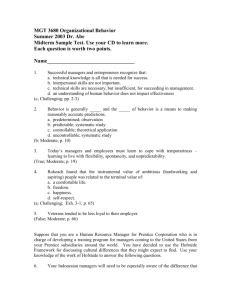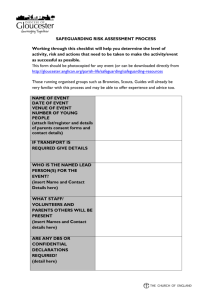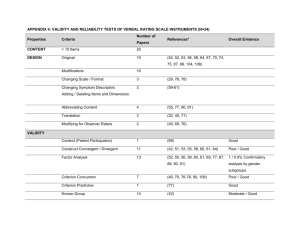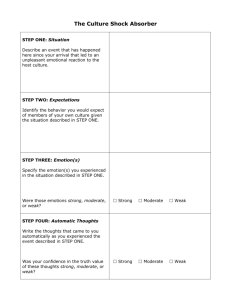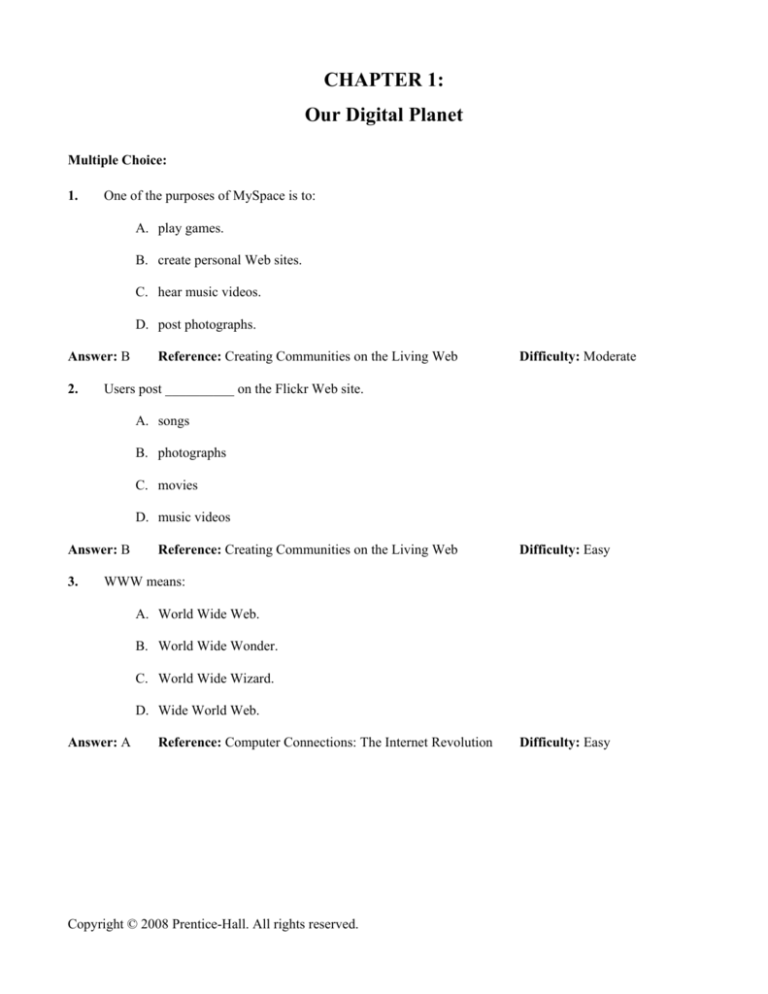
CHAPTER 1:
Our Digital Planet
Multiple Choice:
1.
One of the purposes of MySpace is to:
A. play games.
B. create personal Web sites.
C. hear music videos.
D. post photographs.
Answer: B
2.
Reference: Creating Communities on the Living Web
Difficulty: Moderate
Users post __________ on the Flickr Web site.
A. songs
B. photographs
C. movies
D. music videos
Answer: B
3.
Reference: Creating Communities on the Living Web
Difficulty: Easy
WWW means:
A. World Wide Web.
B. World Wide Wonder.
C. World Wide Wizard.
D. Wide World Web.
Answer: A
Reference: Computer Connections: The Internet Revolution
Copyright © 2008 Prentice-Hall. All rights reserved.
Difficulty: Easy
Chapter 1: Our Digital Planet
4.
Who was instrumental in designing the first mechanical computer that would eventually become the
modern day computer?
A. Bill Gates
B. Charles Babbage
C. John Atanasoff
D. Presper Eckert
Answer: B
5.
Reference: Computers in Perspective
Difficulty: Moderate
This machine was used to crack Nazi Military codes:
A. IBM PC
B. Univac I
C. Macintosh
D. Colossus
Answer: D
6.
Reference: Computers in Perspective
Difficulty: Moderate
This computer correctly predicted that Presidential candidate Eisenhower would be elected:
A. ENIAC.
B. IBM.
C. Univac I.
D. ABC.
Answer: C
7.
Reference: Computers in Perspective
Difficulty: Easy
What is the technological advancement that made it possible for computers to become as small as they are
today?
A. Repeater.
B. Vacuum tube.
C. Transistor.
D. Silicon chip.
Answer: D
Reference: Computers in Perspective
Copyright © 2008 Prentice-Hall. All rights reserved.
Difficulty: Moderate
2
Chapter 1: Our Digital Planet
8.
Computers grew out of a human need to:
A. do shopping.
B. quantify.
C. surf the Internet.
D. buy computers.
Answer: B
9.
Reference: Computers in Perspective
Difficulty: Moderate
Vacuum tubes are eventually replaced by:
A. Laptops
B. Integrated circuits
C. Mouse
D. Calculating machines
Answer: B
10.
Reference: Computers in Perspective
Difficulty: Moderate
The first computers were designed to:
A. perform repetitive calculations and tasks.
B. compose music.
C. use punch cards.
D. assist the U.S. government with defense.
Answer: A
11.
Reference: Computers in Perspective
Difficulty: Challenging
The first general-purpose commercial computer was known as the:
A. Z1.
B. ENIAC.
C. Difference Engine.
D. Analytical Engine.
Answer: A
Reference: Computers in Perspective
Copyright © 2008 Prentice-Hall. All rights reserved.
Difficulty: Challenging
3
Chapter 1: Our Digital Planet
12.
In the late 1940s and 1950s, what invention helped computers become more widely used by businesses, as
well as in science and engineering?
A. Transistors
B. Vacuum tubes
C. CPU’s
D. RAM
Answer: A
13.
Reference: Computers in Perspective
Difficulty: Challenging
What invention, developed in 1948, replaced vacuum tubes?
A. Silicon wafers
B. Transistors
C. The CPU
D. RAM
Answer: B
14.
Reference: Computers in Perspective
Difficulty: Challenging
Due to a need for smaller and more powerful computers, the ___________ was invented and replaced the
transistor-based computers by the mid-1960s.
A. keyboard
B. RAM chip
C. vacuum tube
D. integrated circuit
Answer: D
15.
Reference: Computers in Perspective
Difficulty: Challenging
The name of the rule or law that predicted the power of silicon chips (the CPU) would double about every
18 months is:
A. the CPU doubling rule.
B. Moore’s Law.
C. the Intel Law.
D. Smith’s Law.
Answer: B
Reference: Computers in Perspective
Copyright © 2008 Prentice-Hall. All rights reserved.
Difficulty: Challenging
4
Chapter 1: Our Digital Planet
16.
The invention of the ___________ has had the greatest impact on computers.
A. CPU
B. RAM chip
C. microprocessor
D. monitor
Answer: C
17.
Reference: Computers in Perspective
Difficulty: Moderate
____________ developed the microprocessor.
A. Intel
B. IBM
C. Microsoft
D. Apple
Answer: A
18.
Reference: Computers in Perspective
Difficulty: Moderate
The Silicon Valley, where numerous microprocessor manufacturing companies are located, is in:
A. Oregon.
B. California.
C. Texas.
D. Washington.
Answer: B
19.
Reference: Computers in Perspective
Difficulty: Easy
PC stands for:
A. personal comprehension.
B. personal computing.
C. personal computer.
D. personal calculations.
Answer: C
Reference: Computers in Perspective
Copyright © 2008 Prentice-Hall. All rights reserved.
Difficulty: Easy
5
Chapter 1: Our Digital Planet
20.
Computers that once occupied full rooms, but are now approximately the size of a refrigerator, are used by
large organizations and known as:
A. terminals.
B. personal computers.
C. mainframe computers.
D. supercomputers.
Answer: C
21.
Reference: Mainframes and Supercomputers
Difficulty: Moderate
The communication process between a mainframe and several users simultaneously is known as:
A. timesharing.
B. networking.
C. serving.
D. processing.
Answer: A
22.
Reference: Mainframes and Supercomputers
Difficulty: Moderate
A keyboard and screen that has little, if any, local processing power is known as a:
A. supercomputer.
B. mainframe computer.
C. timesharing device.
D. terminal.
Answer: D
23.
Reference: Mainframes and Supercomputers
Difficulty: Moderate
Supercomputers:
A. are smaller in size and processing capability than mainframe computers.
B. are common in the majority of U.S. households.
C. contain thousands of microprocessors.
D. are rarely used by researchers due to their lack of computing capacity.
Answer: C
Reference: Mainframes and Supercomputers
Copyright © 2008 Prentice-Hall. All rights reserved.
6
Difficulty: Moderate
Chapter 1: Our Digital Planet
24.
What is a computer that provides software and other resources to computers over a network?
A. Server
B. Workstation
C. Mainframe
D. Supercomputer
Answer: A
25.
Reference: Servers
Difficulty: Moderate
When a user has access to a high-end desktop computer with a large amount of processing power, he or she
is using a:
A. server.
B. workstation.
C. supercomputer.
D. terminal.
Answer: B
26.
Reference: Personal Computers
Difficulty: Moderate
When multiple users sharing data and hardware resources need access to one application, a ____________
is necessary.
A. mainframe
B. server
C. supercomputer
D. workstation
Answer: B
27.
Reference: Servers
Difficulty: Easy
Extra-light, notebook computers are sometimes known as:
A. workstations.
B. notebooks.
C. subnotebooks.
D. laptops.
Answer: C
Reference: Personal Computers
Copyright © 2008 Prentice-Hall. All rights reserved.
Difficulty: Moderate
7
Chapter 1: Our Digital Planet
28.
In regard to a handheld device, a docking cradle allows a user to:
A. connect three or more handheld devices together into a network.
B. hook up handheld devices to optical drives such as a CD or DVD.
C. lock the handheld device into a secure location because of the high risk of theft.
D. establish connection between the handheld device and a computer.
Answer: D
29.
Reference: Personal Computers
Difficulty: Moderate
A computer small enough to fit into a shirt pocket or purse is a:
A. notebook.
B. subnotebook.
C. handheld device.
D. mainframe.
Answer: C
30.
Reference: Handheld Devices
Difficulty: Easy
Probably the fastest growing segment of the PC market is the area of:
A. supercomputers.
B. workstations.
C. laptop computers.
D. Macintoshes.
Answer: C
31.
Reference: Personal Computers
Difficulty: Moderate
A negative aspect of a laptop computer is:
A. the low price, thus low quality.
B. the relatively high price and upgrade difficulties.
C. their non-portability because they all weigh at least 10 pounds.
D. the unlikelihood that the same high quality software can be loaded on a portable.
Answer: B
Reference: Personal Computers
Copyright © 2008 Prentice-Hall. All rights reserved.
Difficulty: Moderate
8
Chapter 1: Our Digital Planet
32.
A handheld computer known as a PDA stands for:
A. personal digital assistant.
B. personalized digital assistance.
C. planned digital associate.
D. practical digitized associate.
Answer: A
33.
Reference: Handheld Devices
Difficulty: Challenging
Special-purpose computers use silicon chips that have the program etched into them. This hybrid of
hardware and software is called:
A. networked.
B. firmware.
C. specialized software.
D. embedded.
Answer: B
34.
Reference: Embedded Systems
Difficulty: Easy
Programs such as Internet Explorer that serve as navigable windows into the Web are called:
A. Hypertext.
B. Networks.
C. Internet.
D. Web browsers.
Answer: D
35.
Reference: Computer Connections: The Internet Revolution
Difficulty: Moderate
What utility do you use to transfer files and exchange messages?
A. Email
B. WWW
C. Web browsers
D. Hypertext
Answer: A
Reference: Computer Connections: The Internet Revolution
Copyright © 2008 Prentice-Hall. All rights reserved.
9
Difficulty: Challenging
Chapter 1: Our Digital Planet
36.
This experimental network developed by the U.S. government, scientists and others eventually became the
Internet?
A. Networks
B. ARPANET
C. World Wide Web
D. Internet
Answer: D
37.
Reference: Computer Connections: The Internet Revolution
Difficulty: Challenging
How are the World Wide Web (WWW) and the Internet different?
A. They aren’t different; they are two different names for the same thing.
B. The Internet is text only; the WWW incorporates multimedia.
C. The Internet is primarily used by businesses; the WWW can be used by home users.
D. The WWW is faster than the more archaic Internet.
Answer: B
38.
Reference: Computer Connections: The Internet Revolution
Difficulty: Challenging
Computers have changed the way humans go about their day-to-day lives. Events and ideas radically
change the way people work, live, and think. This dramatic change is known as a(n):
A. paradigm shift.
B. industrial revolution within a country.
C. shift in traditions.
D. counterculture.
Answer: A
39.
Reference: Into the Information Age
Difficulty: Moderate
The time in our history in which large masses of the population moved from farms to factories was the:
A. agricultural age.
B. paradigm shift.
C. industrial age.
D. information age.
Answer: C
Reference: Into the Information Age
Copyright © 2008 Prentice-Hall. All rights reserved.
Difficulty: Easy
10
Chapter 1: Our Digital Planet
40.
The time period in which there was a shift from an industrial economy to an economy based on the value of
information is known as the:
A. paradigm shift.
B. agricultural age.
C. industrial revolution.
D. information age.
Answer: D
41.
Reference: Into the Information Age
Difficulty: Moderate
The software tools that enable a user to interact with a computer for specific purposes are known as:
A. hardware.
B. networked software.
C. shareware.
D. applications.
Answer: D
42.
Reference: Applications: Digital Technology in Action
Difficulty: Moderate
Applications that are designed to do calculations, such as the expenses of a student or sales of a business,
are known as:
A. databases.
B. tax software.
C. spreadsheets.
D. word processors.
Answer: C
43.
Reference: Applications: Digital Technology in Action
Difficulty: Easy
Tasks that have traditionally been performed by people but are now duplicated in an application are part of
the software that is known as:
A. artificial intelligence.
B. networking.
C. artificial knowledge software.
D. networking knowledgeable software.
Answer: A
Reference: Applications: Digital Technology in Action
Copyright © 2008 Prentice-Hall. All rights reserved.
11
Difficulty: Moderate
Chapter 1: Our Digital Planet
44.
When a student posts a clip from a recent movie on her Web site, the ethical issue of ____________ is at
issue.
A. protecting intellectual property
B. protecting privacy
C. using private university property for personal gain
D. All of these answers are ethical issues related to this action.
Answer: A
45.
Reference: Implications: Social and Ethical Issues
Difficulty: Moderate
The future could bring the emergence of ____________, computer chips embedded within human bodies.
A. bio-electronic imaging
B. human-scanning technology
C. digital-assistance human-existence technology
D. biodigital technology
Answer: D
Reference: Implications: Social and Ethical Issues
Difficulty: Challenging
Fill in the Blank:
46.
You can create your own personal Web page using ____________.
Answer: MySpace
47.
Difficulty: Easy
Reference: Computers in Perspective
Difficulty: Challenging
A single silicon chip is also called a(n).
Answer: microprocessor
50.
Reference: Communities on the Living Web
____________ is the prediction by a chairman of Intel in the 1960’s that CPU power would double
approximately every 18 months.
Answer: Moore’s Law
49.
Difficulty: Easy
____________ is an online community to share Photos.
Answer: Flickr
48.
Reference: Communities on the Living Web
Reference: Computers in Perspective
Difficulty: Challenging
A bank teller or a travel agent most likely will use a(n) ____________, which is a combination of keyboard
and monitor with little, if any, local power.
Answer: terminal
Reference: Mainframes and Supercomputers
Copyright © 2008 Prentice-Hall. All rights reserved.
12
Difficulty: Moderate
Chapter 1: Our Digital Planet
51.
____________ are the most powerful of all computers.
Answer: Supercomputers
52.
Reference: Servers
Difficulty: Challenging
PC stands for ___________.
Answer: personal computer
54.
Reference: Personal Computers
Reference: Computer Connections: The Internet Revolution
Reference: Computer Connections: The Internet Revolution
Reference: Computer Connections: The Internet Revolution
An experimental network backed by the U.S. government eventually evolved into the ___________.
Answer: Internet
Difficulty: Easy
61.
Difficulty: Moderate
A(n) ____________ is a playing console which has internet connections
Answer: Xbox 360
Difficulty: Moderate
60.
Reference: Embedded Systems
Internet usage in this country will dramatically ___________ in the future.
Answer: increase
Difficulty: Easy
59.
Difficulty: Moderate
Email stands for ___________.
Answer: electronic mail
Difficulty: Easy
58.
Reference: Handheld Devices
Over 90% of the world’s microprocessors are found in ____________ computers.
Answer: embedded
57.
Difficulty: Moderate
Handheld computers are referred to as ____________.
Answer: personal digital assistants or PDAs
56.
Difficulty: Challenging
A light-weight, flat-screen, battery-powered computer that can be carried in a briefcase is known as a(n)
___________.
Answer: portable computer or Subnotebook Reference: Personal Computers
55.
Difficulty: Easy
A networked computer that contains software and data for other computers is a(n) ____________.
Answer: server
53.
Reference: Mainframes and Supercomputers
Reference: Computer Connections: The Internet Revolution
In the early 1990s, the Internet transformed into a multimedia environment known as the ____________.
Answer: World Wide Web
Difficulty: Easy
Reference: Computer Connections: The Internet Revolution
Copyright © 2008 Prentice-Hall. All rights reserved.
13
Chapter 1: Our Digital Planet
62.
A(n) ____________ is a program that allows access to the WWW.
Answer: Web browser
Difficulty: Moderate
63.
Many digital devices are connected together by ____________.
Answer: networks
Difficulty: Moderate
64.
Reference: Computer Connections: The Internet Revolution
Reference: Computer Connections: The Internet Revolution
The ____________ ushered in the Industrial age.
Answer: Industrial Revolution Reference: Into the Information Age
65.
In the ____________, most people earn their living working with words, numbers, and ideas.
Answer: Information Age
66.
Reference: Applications: Digital Technology in Action Difficulty: Moderate
Reference: Applications: Digital Technology in Action Difficulty: Moderate
The software that combines audio and video with text and graphics is called ____________.
Answer: Multimedia
71.
Reference: Applications: Digital Technology in Action Difficulty: Moderate
If you work with numbers, you will probably use a(n) ____________.
Answer: Spreadsheet
70.
Reference: Applications: Digital Technology in Action Difficulty: Moderate
A(n) ____________application can be used to prepare polished, visually exciting publications.
Answer: desktop publishing
69.
Difficulty: Moderate
A(n) ____________ is a door into a world of online communication.
Answer: network application
68.
Reference: Into the Information Age
____________ are the software tools that transform general-purpose computers into specialpurpose tools.
Answer: Applications
67.
Difficulty: Moderate
Reference: Applications: Digital Technology in Action Difficulty: Moderate
____________ is the branch of computer science that explores the use of computers in tasks that
require intelligence
Answer: Artificial intelligence Reference: Applications: Digital Technology in Action Difficulty: Moderate
72.
The gap between information technology “haves” and “have nots” is called the ____________.
Answer: digital divide
Reference: Implications: Social and Ethical Issues
Copyright © 2008 Prentice-Hall. All rights reserved.
14
Difficulty: Moderate
Chapter 1: Our Digital Planet
73.
Computers can threaten our ____________, our security, and perhaps our way of life.
Answer: privacy
74.
Reference: Implications: Social and Ethical Issues
Difficulty: Moderate
A(n) ____________can also have cell phone capabilities.
Answer: PDA
Reference: Handheld Devices
Difficulty: Moderate
Matching:
75.
Match the following terms to their meanings:
I.
MMORPG
A. games such as EverQuest
II.
Internet
B. the way that millions of Web pages are tied together
III.
Xbox 360
C. the graphical portion of the Internet
IV.
World Wide Web
D. program to surf the WWW
V.
Electronic mail
E. link computers together
VI.
Networks
F. transfer files and exchange messages
VII. Web browser
G. modern video game console
VIII. hypertext link
H. global collection of networks
Answers: A, H, G, C, F, E, D, B
Difficulty: Moderate
Reference: Computer Connections: The Internet Revolution
Copyright © 2008 Prentice-Hall. All rights reserved.
15
Chapter 1: Our Digital Planet
76.
Match the following terms to their meanings:
I.
subnotebook
A. a computer that provides software, data, and other resources to other
computers over a network
II.
server
B. a high-end PC
III. workstation
C. handheld computer
IV. supercomputer
D. extra-light, ultra-mobile notebook computer
V.
E. refrigerator-sized computer used by large organizations
mainframe
VI. terminal
F. just a monitor and keyboard
VII. PDA
G. the fastest, most powerful computer
Answers: D, A, B, G, E, F, C
Difficulty: Moderate
Reference: Computers Today: A Brief Taxonomy
Copyright © 2008 Prentice-Hall. All rights reserved.
16



